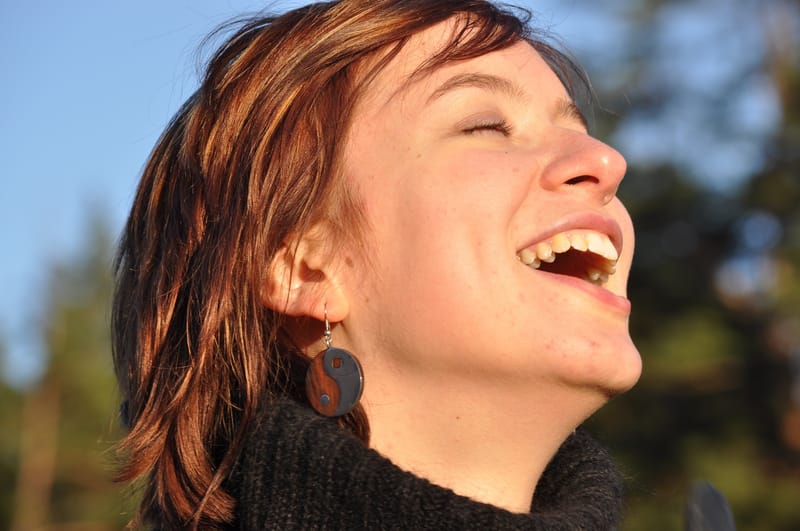8) Laughter Therapy

A laughing matter about a serious subject
The trial is the brainchild of lead investigator Dr. Ted Brown, director of neurorehabilitation at the EvergreenHealth Multiple Sclerosis Center in Washington state.
“The goal of the study is to prove that laughter therapy is effective, that the hypothesis that it is effective is true,” Brown told Healthline.
Brown added he also wants to “spread the word” on laughter therapy, so people will give it a try.
Brown started offering a laughter therapy program for his MS patients in 2014, and quickly expanded the therapy to treat other neurological disorders.
“Many patients are disabled and can’t walk, or even have hand function.” Brown explained, “There are not a lot of exercise options for them, but they can do this. They can laugh.”
Laughter is considered an aerobic exercise, and 50 minutes of laughter can help build up the core and facial muscles, he said.
The EvergreenHealth MS Center sees between 800 and 900 people with MS per year.
Brown learned about laughter therapy by experiencing it firsthand during a conference.
Feeling it would have a positive effect on his patients with MS, he connected with laughter yoga instructor and trainer Julie Plaut Warwick, and brought it to his clinic.
He said the results were successful and encouraging enough to develop a clinical study.
How the new study works
Brown created the protocol for the study.
It was approved by an independent review board, and received funding through the Evergreen Foundation.
The participants are currently on the last of three sessions.
Each session has eight to 10 participants and lasts eight weeks. Participants must live in the Kirkland, Wash., area and be able to attend the program in person.
If this trial proves his hypotheses, the next step could be a pilot program.
The therapy program consists of breathing exercises, laughter, relaxation, and pleasant conversations.
When Brown asks participants what were the biggest benefits, they say they “feel less anxious, less depressed.”
In addition, Brown said laughter therapy “is a great way for people with disabilities to exercise, for meeting other people, and being social.”
Why laughter works
Laughter therapy is not about being silly or goofy, explained Sebastien Gendry, head of faculty at the Laughter Online University at the Laughter Wellness Institute.
“Anyone can fake a laugh,” Gendry told Healthline.
What makes this therapy work is that it comes from deep inside.
“[It’s] a shift in attitude that makes the difference,” he said. “Creating distance between what we think is painful and what actually is pain.”
“Laughter does not mean happiness. It is a way to relieve tension,” Gendry said. “It is a simple and impactful way to improve immune function by increasing cardiovascular activity and improving lymphatic function with deep breathing and increased oxygen.”
Terry Schuster is yoga laughter advocate who also has MS. She was diagnosed in 1990 after her body went numb during an aerobics class.
After trying many treatment options, Schuster received an HSCT stem cell transplant in April in Russia.
“The depression gets real,” Schuster told Healthline, but she “always tries to perk herself up.”
Schuster has used aqua therapy and yoga.
She said she has also tried just about everything to help her live better with MS. She was in a book group until her work got in the way. She attends events such as adaptive sports when she is able.
Currently she uses a cane, but has been able to try kayaking and other activities.
When asked how laughter therapy has helped with her MS, Schuster replied that she “feels more energized and more capable. That the energy from the inside goes to the outside. I get the feeling that ‘I can,’ and I walk to the car with a heightened sense of energy.”

Combining laughter and yoga
Plaut Warwick started her laughter yoga program in 2014, offering it to just people with MS. She quickly expanded the therapy to treat people with other neurological disorders upon seeing the positive results.
She told Healthline that it’s amazing to watch as the people with these conditions share their lives, how they change their perspectives to enjoy life, and have a renewed sense of energy.
Plaut Warwick shared a story of someone fighting disabling fatigue who “went home after laughter class, and did laundry — all of it, then cooked the entire dinner, then took a nap.”
But studying laughter is difficult, she explained.
First of all, the person has to be willing to laugh, and be willing to open themselves up in front of strangers.
People also don’t breathe deeply or take time to meditate.
The therapy can be difficult physically and emotionally. When participants are emotional, then breathe deeply and laugh, they can end up vulnerable. They could be happy or sad or could cry.
“The point is to get it out,” Plaut Warwick said.
She uses people’s stories as her litmus test for telling how the therapy is working. She has found that her participants are able to be a bit more flexible and move their limbs a bit more.
She also found participants were able to change their ways of thinking and be more positive about themselves when they leave class.
She explained that, “Through laughter exercises we are oxygenating our body — creating endorphins, and reminding our body that it is still here and alive.”
… Unconditional laughter, when no joke is needed... Just laughing to laugh.
https://www.youtube.com/watch?v=1veWbLpGa78
https://www.youtube.com/watch?v=RP4abiHdQpc



